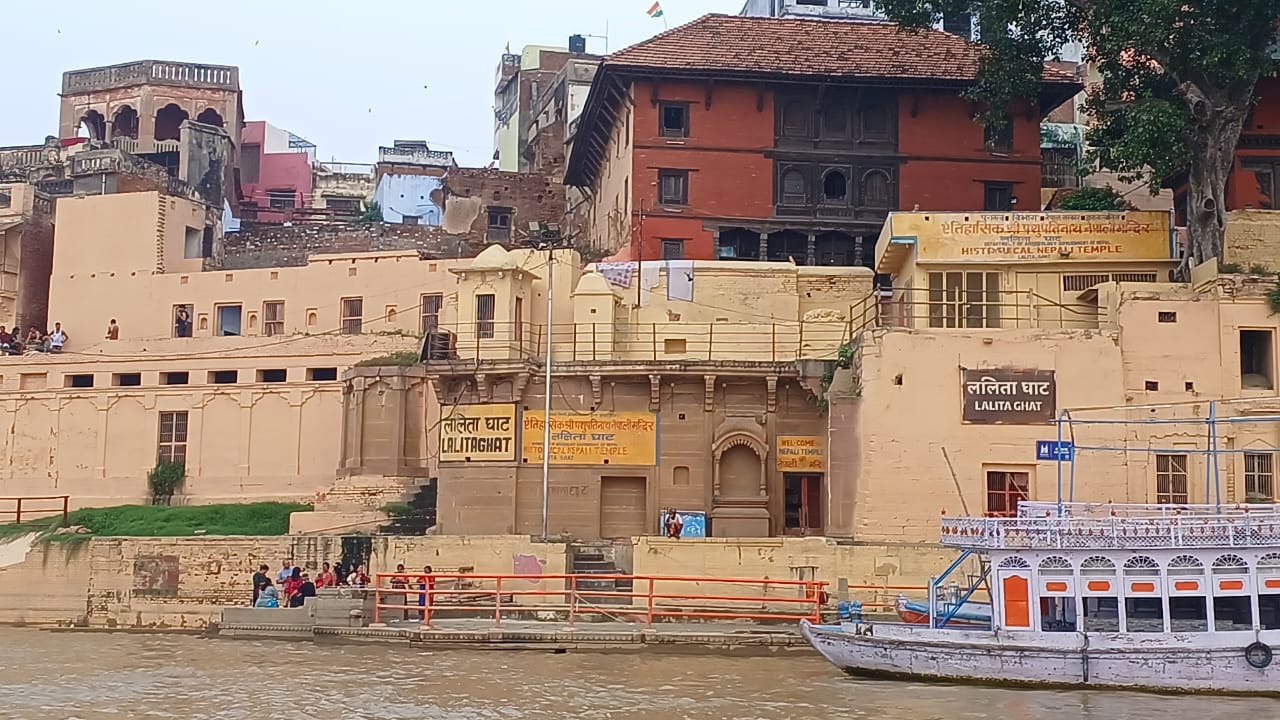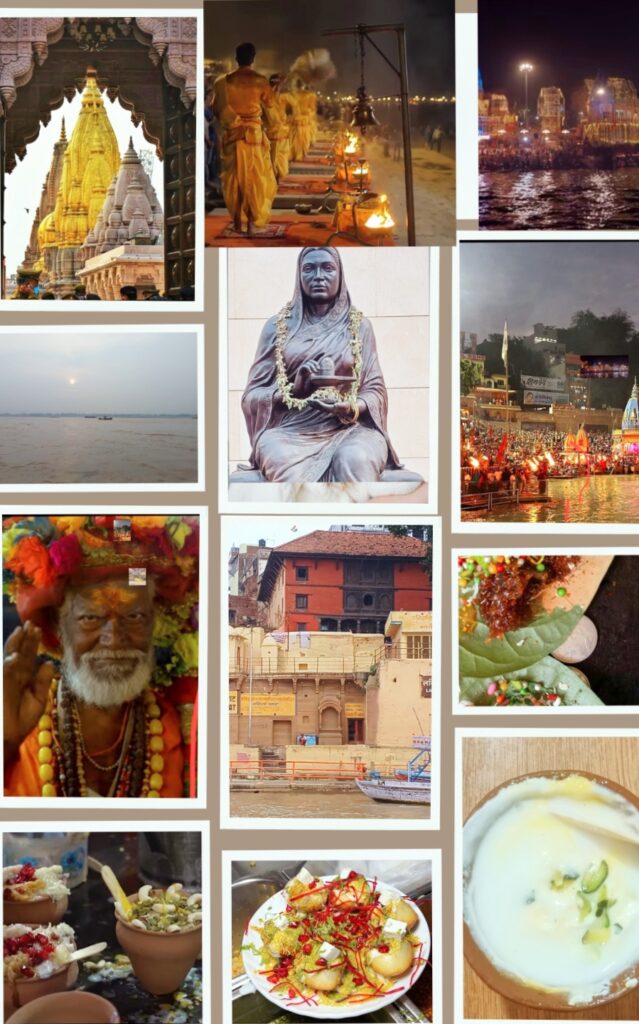
I had been reading about Kashi for quite sometime but never picked up the courage to visit the city. Besides being a city of temples and spirituality it was also one of chaos, unwinding narrow lanes and not so clean ambience Being a stickler for cleanliness, I dreaded the very thought of going there. But suddenly one fine day I told Hubby that I would like to visit the city which Lord Shiva had himself been too and which endeared all the Gods to visit the city and stay there. Hubby just wasn’t sure. But after much convincing and assurances, I was soon on board a flight to this amazing city.
Kashi is part of the city of Varanasi or Banaras, a place where traditions, spirituality and tales of bygone era have withstood time. The structures and buildings standing side by side inter wined by narrow lanes makes one believe that time has stood still in this part of the city. Nothing has changed but each structure has a story to tell as they were witness to incidents which we as ordinary humans cannot fathom.
The Beginnings :
Mark Twain said that Kashi is ‘older than legend’. One can never decipher the date on which this place was created. When Athens was not even thought of, Kashi was. When Rome did not even exist in people’s minds, Kashi did. No one knows how old it is. Legend has it that Lord Shiva himself stayed here with his wife. But before He came to Kashi, he sent a number of his messengers to see the place and report to him. But all who came here fell in love with the city and stayed back never to return and tell Shiva about this glorious city. Finally he had to come himself.
What Did We See?
The Kashi Vishwanath Temple
Kashi is intriguing. There are many places to see. The most important being the Kashi Vishwanath Temple. It is among the most important Hindu temples in India and is one of the 12 temples where Lord Shiva is believed to have appeared as a column of light.
The Kashi Vishwanath Temple stands on the west bank of the Ganga. Lord Shiva has been worshipped here for hundreds of years as Vishwanatha or Vishweshwara, “Lord of the Universe.” The temple was destroyed many times by invading Mughal kings. The present structure was rebuilt by Ahalya Bai Holkar of the Holkar dynasty in the 18th century. The present structure, is popularly known as the ”Golden Temple” because of the gold used in the spires and domes. It is believed that visiting the Kashi Vishwanath Temple and bathing in the Ganges are important stages to the path to liberation or moksha. Tens of thousands of pilgrims visit the temple daily. Every year during Mahashivaratri, a great procession takes place from the Mahamrityunjaya Temple to the Kashi Vishwanath Temple.
PC: X
The Ghats
There are “Ghats “along the Ganges which are basically riverfront steps leading to the banks of the river. The city has 88 ghats. Most of them are for bathing and puja ceremonies while two are used exclusively as cremation sites. Most of the ghats were rebuilt after 1700 AD, when the city was part of the Maratha Empire. The well known ones are the Assi ghat,Dashwamedha,Manikarnika,Darbhanga, Harischandra,to name a few.
Although we visited a number of ghats I would like to mention two of the most popular ones- Dashwamedha and Manikarnika Ghats.
Dashwamedha Ghat: This is the oldest and the most popular ghat. It is here where the Ganga Arati takes place at dusk, a heavenly sight which even the Gods would enjoy. Amidst the chanting of Mantras, blowing of conch shells the priests all in same colored attire of dhoti and kurta, venerate the Ganga, the lifeline of Varanasi, with brass lamps that rise several tiers. The hour-long ritual can be watched from the ghat or boats moored on the river bank. The Ganga Arati is an experience which is unique and spiritually enlightening.The Arati was rejuvenating and mesmerizing.
The name ‘Dashashwamedh’ refers to the place where Lord Brahma sacrificed ten horses. It is also said that Bajirao Peshwa I, had the ghat reconstructed in 1740 AD. It was later reconstructed by the queen of Indore, Ahilyabai Holkar, in 1774. This ghat lies very close to the famous Vishwanath Mandir.
An evening of bliss,The Ganga Arati
Manikarnika Ghat: Flanked by the Dashwamedha Ghat and the Scindia ghat , Manikarnika ghat has a special significance to the Hindu religion. There are many tales behind the existence of this place. Some say that when Goddess Sati self destroyed herself, (as she could not bear the insults inflicted on her husband, God Shiva,by her father and others) parts of her body fell in various places, when Shiva carried her corpse and wandered from place to place. Where ever the parts fell, the places were designated as “Shakti Peeths”. Her earing is said to have fallen in Kashi and the exact place is the Manikarnika ghat There is a well present her also, known as Manikarnika Kund.
It is believed that a person cremated here attains moksha or liberation; in fact it is a special and cleansing location for one’s last ritual. In Hindu tradition, cremation in Kashi plays a crucial role in breaking the cycle of rebirth.
I was surprised at the number of people who visit this ghat to meditate, sit and contemplate or to take pictures of burning pyres. One experiences a different feeling here, not of anxiety or fear ,but in one, dawns the realization of the ultimate truth of life. As you move through the narrow lanes of Kashi you would often face processions of people- family and friends- carrying the dead bodies of their loved ones amidst chants of “Ram Naam Sathya Hai”(“The name of Lord Rama is the truth.”).
What Else To See?
Besides the famed Kashi Vishwanath Temple and Ghats there are other places where one can visit. Plan a day trip and visit the Durga temple, Sankat Mochan Hanuman Mandir, Ramnagar Fort, Sri Satyanarayan Tulsi Mandir, Kaal Bhairav Temple, the famous Banaras Hindu University as well as the innumerous temples here. Sarnath,located 10 kilometres (6.2 miles) northeast of Varanasi near the confluence of the Ganga and the Varuna rivers, is where, at 35 years of age, Gautama Buddha gave his first sermon, after attaining enlightenment at Bodh Gaya. It is also where the Buddhist Sangha first came into existence as a result of the enlightenment of his first five disciples. It is worth a visit.
Get up early and take a boat ride on the Ganges and witness the morning arati.
Sunrise On The Ganga River, Taken From The Boat
An Offering to Ma Ganga
How To Get to Kashi?
One can travel to Varanasi by trains, buses or by air. To go to Kashi, one can take a taxi or a cycle/auto rickshaw to reach a locality called Lahori Tola. Once there, look out for the entry gate of Kashi Vishwanath temple. As you enter this gate, you will pass into a narrow lane called Vishwanath Gali, which is full of sweet shops, items of worship,eateries etc. Vishwanath Gali is the easy and most well-tread passage to reach the Kashi Vishwanath temple. The ghats are surrounding this area so one can easily walk through the narrow lanes and reach the temples or ghats. The newly built Kashi Vishwanath corridor connects the iconic Kashi Vishwanath temple and the ghats along the river Ganga. It ensures an easy movement of pilgrims and devotees between the ghats and the temple.
Ahilyabai Holkar
Bharat Mata
Kashi Vishwanath Corridor
A lasting Impression!
As I left Kashi, I felt that there was much more left to explore in this city and an urge to return still persists. The spiritually significant spaces here leave an indelible mark on one’s mind. Spending time in this blessed city helps in engineering one’s inner well being .

